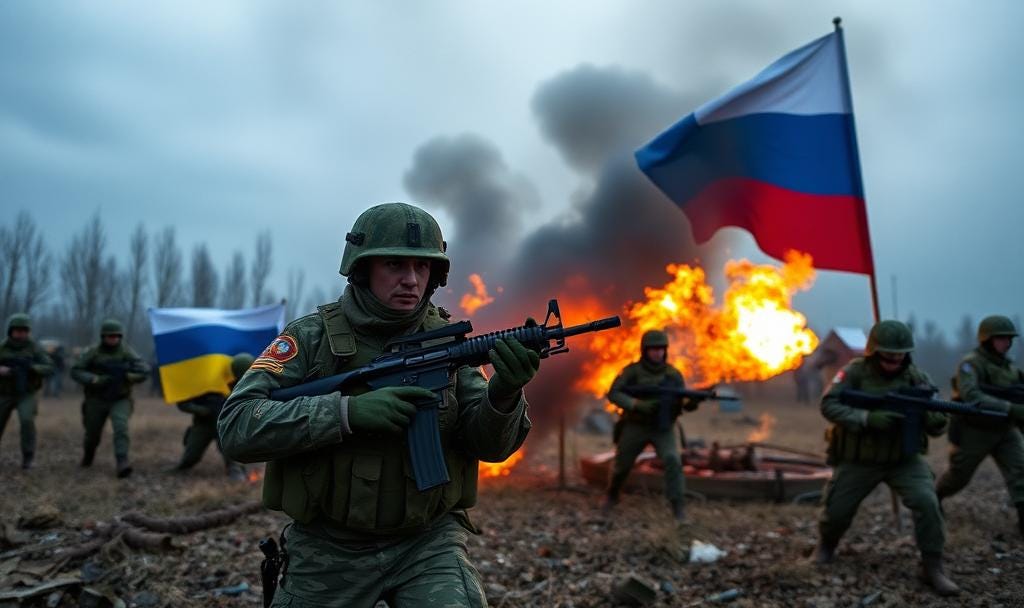Russia-Ukraine War Amid Escalating Tensions
The Russia-Ukraine war has now reached its 1,101st day, with no clear resolution in sight as diplomatic efforts stumble and military actions escalate. Recent developments include a tense meeting between Ukrainian President Volodymyr Zelenskyy and U.S. President Donald Trump, who reportedly delivered an ultimatum: "You're either going to make a deal, or we're out." Meanwhile, Russia persists with its aerial assault campaign, while Ukraine's air defenses successfully intercepted 103 of 154 drones in a recent overnight strike. The conflict has led to verified civilian casualties totaling 41,783, including 12,605 deaths, as reported by the Office of the United Nations High Commissioner for Human Rights (OHCHR).
Battlefield Developments
The war continues to take a heavy toll on both sides, with British intelligence estimating that as many as 860,000 Russian service personnel have been killed or wounded since the invasion began in February 2022. Ukrainian casualties are estimated at approximately 400,000 killed or injured, according to January 2025 figures.
Russian forces have recently advanced in several areas, including Kursk Oblast and near Kupiansk, Lyman, and Velyka Novosilka, while Ukrainian forces have made limited advances near Kupyansk. The situation in Toretsk remains particularly contested, with a Kremlin-affiliated Russian military blogger describing it as a "big contested grey zone."
"Russian forces are unable to transfer equipment into Toretsk and move around the settlement in small infantry groups due to the threat of Ukrainian drone strikes," reported the Russian military blogger.
In Odesa, a Russian drone assault resulted in one fatality and injured another person, igniting fires at both a private residence and a commercial establishment1. Kharkiv, Ukraine's second-largest city, also suffered attacks on a medical center and other sites, with five to seven people reported injured and at least 50 evacuated from the targeted medical facility.
Diplomatic Impasse
The diplomatic front shows increasing strain as competing draft resolutions circulate at the United Nations. Ukraine and EU member states have crafted a resolution calling for de-escalation, a halt to hostilities, and reaffirming Ukraine's sovereignty within its internationally recognized borders. This contrasts with a U.S.-drafted resolution that reportedly uses different language, referring to the "Russia-Ukraine conflict" instead of "the full-scale invasion of Ukraine by the Russian Federation."
The U.S. has reportedly urged Ukraine to withdraw its draft resolution and join the American initiative, arguing that the Ukraine-EU text would hinder progress toward a sustainable peace agreement. However, Ukraine and the EU have opted to proceed with their resolution.
Russian President Vladimir Putin has implicitly recognized Zelenskyy as the legitimate president of Ukraine and a potential negotiating partner, while simultaneously promoting information operations aimed at destabilizing Ukrainian society and its military from within. Putin has also attempted to reframe his long-standing calls for regime change in Ukraine, which date back to 2021.
Military Aid and International Support
Support for Ukraine from Western countries continues but faces challenges. Spain's Prime Minister Pedro Sanchez announced that around €1 billion in military equipment will be sent to Ukraine from Spain in 2025. However, Ukraine's war effort is being tested by shifting global politics, with delays in vital military aid and changing leadership in major global powers like the United States emboldening Russian advances.
"Ukraine's resilience is being profoundly tested as geopolitical shifts and battlefield setbacks redefine the conflict," remarks a recent analysis from Solace Global.
Humanitarian Impact
The human cost of the war remains staggering. Beyond the verified civilian casualties, the conflict has displaced 10.2 million Ukrainians, which accounts for 23% of the pre-invasion population of 44 million. In contrast, Russia has seen approximately 800,000 citizens emigrate for economic or political reasons, making up 0.6% of its population.
Ukraine's infrastructure has been devastated, with 64% of its electricity generating capacity destroyed or occupied, forcing it to rely on external sources. This has led the country to face significant power shortages. The economic impact has been severe, with Ukraine experiencing a 22.6% GDP contraction since 2022, though a modest 2.5% growth is forecast for 2025.
Russian Internal Developments
The Kremlin continues its efforts to implement the "Time of Heroes" program, which assigns veterans of the war in Ukraine to government positions, in order to establish a new Russian elite made up of loyal and ultranationalist veterans who will gradually militarize Russian society. Interestingly, the BBC Russian Service reported that over 100 Russian government, military, and security officials accused and convicted of various corruption charges are currently fighting in Ukraine.
Russia's economy has demonstrated resilience despite international sanctions, experiencing a 5.6% GDP growth since 2022 and a forecast of 1.6% growth for 2025. However, the country faces challenges in military recruitment. Authorities in Samara Oblast have reduced payments to soldiers who had temporarily increased their military service contracts after initially raising these payments but later scaling them back.
Future Outlook
As the war approaches the end of its third year, the prospects for a negotiated settlement remain grim. The competing UN resolutions highlight the international community's divided stance on resolving the conflict. Russia's ongoing aerial bombardment campaign and ground operations show no immediate reduction in hostilities, while Ukraine's ability to maintain its defense depends heavily on sustained Western support.
The economic and humanitarian toll continues to rise, particularly for Ukraine, whose infrastructure and economy have sustained significant damage. Without a major shift in the military balance or a diplomatic breakthrough, the conflict is likely to persist into the foreseeable future, as both sides pursue advantages on the battlefield to strengthen their positions in any negotiations.
The war's outcome may ultimately hinge on factors beyond the immediate battlefield, such as the sustainability of Western military aid, Russia's capacity to sustain its war economy, and the resilience of Ukrainian society amid ongoing attacks on civilian infrastructure.



